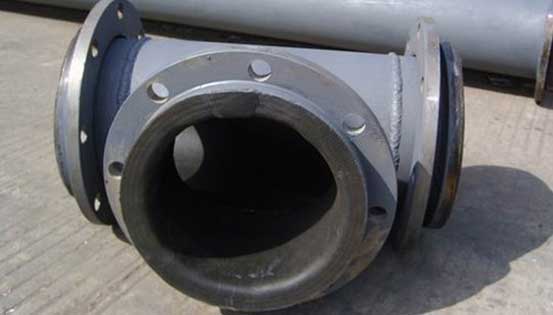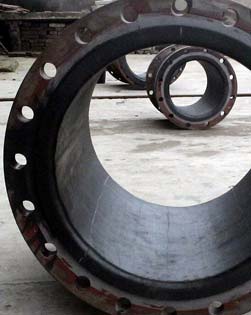What is Rubber Lining?
Rubber lining is a rubber sheet or membranes used for protection from corrosion in aggressive chemical environments. There are several rubber Lining applications some of which include resistance to acid, chemicals and alkalis, abrasion resistance, infect protection.Uses of Rubber Linings
Rubber linings are used in a variety of applications like the chemical, mining, fertilizer, electrochemical, steel, transportation and environment sectors. Rubber linings are used for protection against corrosion and metal and chemical impurities. Using the most advanced technology, the linings are produced in different thicknesses to be used in a variety of industrial situations. Available in a variety of rubber types, the various uses of linings are as follows:- Rubber linings are used to extend equipment life
- Linings also provide solutions for the:
- Toughest abrasion and corrosion applications.
- Extreme chemical environments.
- Severe wear situations.
Types of Rubber for Linings
Both the types of rubber- natural rubber and synthetic rubber- are used for making different varieties of rubber linings. The type of rubber depends upon the purpose and application of rubber lining.
Natural Soft Rubber Linings
Natural soft rubber linings are usually made from various types of poly soft rubber. These types of rubber have such characteristics as low hardness, high resilience, and flexibility. They are abrasion resistant linings capable of absorbing and repulsing the impact of abrasive forces of material handled. They are suitable for slurry tank lining, pipe lining, pump lining etc. Natural soft rubber linings are also used for pickling tanks, storage tanks resistance to hydrochloric acid and sulphuric solutions.
Hard Rubber Linings
Hard rubber linings are generally made from various types of poly hard rubber. They are chemical resistant linings with good flexibility and high impact resistance. Some of them are graphite based rubber linings having excellent chemical resistance at high temperatures and some others are exhaust steam vulcanized rubber linings that are suitable for lining vessels, which can't be cured with pressurized steam. These various types of hard rubber linings are suitable for storage tanks, reactors, plants which use ion exchange membrane process, pipes at high operating temperatures etc.


Synthetic Rubber Linings
Various types of synthetic rubber like chloprene rubber, butyl rubber, and hypalon rubber are used for making these types of rubber lining.
Chloprene Rubber Lining- These rubber linings are commonly made from polyprene rubber having good weathering and ozone cracking resistance. They also have better oil, acid and abrasion resistance. Chloprene rubber linings are suitable for desalination plants, sea water piping, lining for water box, site joints of CWP, vessels etc.
Butyl Rubber Lining- Butyl rubber has excellent chemical resistance at high temperatures. These rubber linings are also very durable due to the inherent low vapor permeability. Butyl rubber linings are, therefore, good for use in vessels, pipes for acid plants, FGD, hypochloride storage and transport.
Chlorobutyl Rubber Lining- Chlorobutyl rubber linings made of chlorobutyl have properties similar to butyl rubber lining but are more easier to apply. They have heat resistance upto 200°F. These linings are unaffected by cold weather or rapid temperature changes.
Hypalon Rubber Lining- These types of rubber linings are based on chloro sulphanated polyethylene rubber having superb chemical resistance to oxidizing acids at high concentrations. Hypalon rubber linings are also available in pre vulcanized form. They are good to be used in vessels, pipes for high acid concentration, and hypo chlorite service.
EPDM Rubber Lining- EPDM rubber has high tensile strength along with excellent resistance to punctures, UV radiation, weathering and microbial attack. As it is highly flexible material with a low co-efficient of thermal expansion and contraction, EPDM lining can be applied in a wide range of temperatures and terrains. These characteristics of EPDM rubber not only makes it suitable for linings but also for rubber coating. As far as EPDM rubber linings are concerned, they are suitable for all types of pond lining such as decorative ponds, golf course ponds, irrigation ponds as well as other water features like lakes & streams, canals and channels, reservoirs etc. They are also suitable for lining in landfill caps, waste water treatment facilities, and fish hatcheries.
We cater to wholesale supply of Rubber Lining. For bulk requirement of Rubber Lining, Industrial Rubber Lining, Natural Rubber Lining, send us online enquiry and you will get prompt response from genuine rubber lining manufacturers and suppliers.Click here to send enquiry.
Applications of Rubber Linings
- Rubber Lining of Tanks: Rail Car Tanks, Elutriation tank by acid, Removal tank of grease, Plating tank, Bottom tank.
- Mining Wear Parts
- Chemical industry: Storage tanks of hydrochloric acid and sodium hydroxide, Reaction vessel, Heat exchanger, Filtration equipment, Condenser, Tank lorry, Piping, Vibration mill machine, and others.
- Unvulcanised linings for shop and field use.
- Pre-vulcanised linings primarily for large erected tanks.
- Self-vulcanising or chemical curing rubber sheets for repair work.
RELATED ARTICLES
- Anti Vibration Mountings
- Automobile Rubber Products
- Calendered Rubber Products
- Extruded Rubber Products
- Medical Rubber Products
- Metal Bonded Components
- Rubber Adhesives & Sealants
- Rubber Ball
- Rubber Bands
- Rubber Beading
- Rubber Bearing
- Rubber Belt
- Rubber Buckets
- Rubber Bullets
- Rubber Cable
- Rubber Coating
- Rubber Duct
- Rubber Expansion Joints
- Rubber Flooring/Matting
- Rubber Footwear
- Rubber Gloves
- Rubber Injection Parts
- Rubber Lining
- Rubber Magnets
- Rubber Molded Products
- Rubber Pads
- Rubber Rollers
- Rubber Stopper
- Rubber Suit
- Rubber Track
- Rubber Valve
- Rubber Balloon
- Rubber Stamps
- Rubber Fenders
- Acrylic Rubber (ACM)
- Butadiene Rubber (BR)
- Butyl Rubber (IIR)
- Chlorosulfonated Polyethylene(CSM)/ Hypalon
- Ethylene Propylene Diene Monomer
- Fluoroelastomers (FKM)/Viton
- Isoprene Rubber (IR)
- Nitrile Rubber (NBR)
- Perfluoroelastomer (FFKM)
- Polychloroprene (CR)/Neoprene
- Polysulfide Rubber (PSR)
- Silicone Rubber (SiR)
- Styrene Butadiene Rubber
How to Make a Custom Rubber Stamp?
Whenever designing a custom stamp for your company, never compromise on its quality because in the end it is the most...
Read MoreLatex and Silicone Rubber Tubing - A Comparison!
Many industries use rubber tubing for various purposes. In fact, various types of rubber tubing are used for different applications...
Read MoreSilicone vs Acrylic Adhesive- A Comparison
Silicon and acrylic adhesives are those rubber adhesives that are widely used in Polyimide tapes. In fact, the polyimide...
Read More

